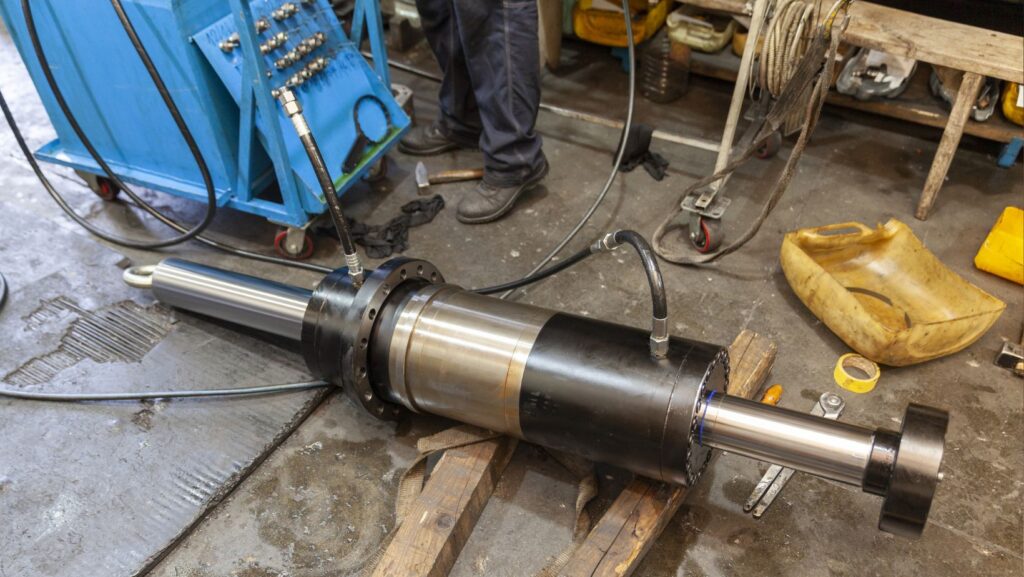
On marine vessels operating 5,000–7,000 hours per year, cylinder liners gradually wear as piston rings move along the running surface. The original grid pattern of the liner, which is there to keep the lubricating oil evenly distributed, will always become smoother over time. This means that fuel consumption and oil usage can increase significantly. For this reason, honing is used as part of standard procedures to restore piston surfaces to functional condition.
Why Cylinder Liner Surface Condition Matters
In a medium-stroke marine engine with a bore between approximately 300 and 500 mm, the liner does not remain perfectly cylindrical throughout its service life. Its shape will gradually change due to thermal stress and mechanical forces. Sometimes this results in ovality or a trumpet-like widening near the top or bottom of the stroke.
At the same time, repeated piston movement can glaze the running surface until it becomes polished and unable to retain oil. When this occurs, the piston rings lose their controlled lubricating film and begin to scrape rather than slide. This can raise friction temperatures, accelerate ring wear, and create local hot spots that encourage micro-scoring. Fuel consumption may also increase as combustion chamber efficiency changes.
Among the measures necessary to optimize ships, keeping piston liner surfaces sufficiently balanced to support consistent engine behavior is always important. If problems exist, they are often identified through visual inspection during scheduled maintenance, or by monitoring oil feed adjustments made to maintain acceptable wear readings.
Honing vs Deglazing: Clarifying the Terms
For periodic piston overhauls, engine manuals specify whether the liner requires complete geometric correction or if refreshing the surface is sufficient.
Deglazing is used when the liner has become smooth or shiny but has not lost its original dimensions. It involves lightly removing the glazed layer to restore a surface that can hold oil, without altering the overall shape. This operation is generally appropriate for engines running on low-sulfur fuels, where wear is slow but polishing can still occur.
Honing, on the other hand, is necessary when the liner is deformed or has a visible wear edge. In this case, material is removed more deliberately to restore both the cylindrical shape and a usable texture.
The distinction is important because an overpolished liner with no geometric defects responds well to deglazing, whereas a liner with ovalization or trumpeting requires honing to prevent subsequent instability of the piston rings. Choosing the appropriate method helps maintain predictable engine performance and regular service intervals.
When Honing Becomes Necessary in Large Marine Engines
During cylinder overhaul, the liner is generally checked at several heights using an internal micrometer. When the measured diameter has increased by approximately 0.05 to 0.10 mm since the last overhaul, or when the ovality exceeds the manufacturer’s limit at defined measurement levels, honing is necessary.
Visual signs include a shiny, mirror-like section where the crosshatch is no longer visible, or a detectable step at the upper reversal point of the ring pack. In such cases, honing restores both the cylindrical form and the surface roughness. The crosshatch pattern is reproduced to retain lubricant, so that the rings seat evenly during operation, helping to stabilize wear rates.
The Trade-offs: Speed, Precision, and Operational Risk
Honing can be performed manually or automatically. Automated honing reduces the time spent per liner. This is particularly the case for engines with a bore exceeding 400 mm, where manual adjustments are tedious and repetitive. It also improves consistency and helps to avoid variations in surface texture or angle due to operator fatigue.

However, the electric system for automated honing relies on a stable power supply and accurate setup, meaning that incorrect parameter entry may result in uniform but unintended surface characteristics. Training is therefore important so that operators understand how each parameter affects ring seating and oil retention.
Manual or semi-automatic honing, on the other hand, can adapt to confined engine rooms and difficult access conditions but depends more heavily on the operator’s judgement. Factors such as small variations in stroke rhythm or stone pressure can influence the final geometry.
Choosing between the methods often comes down to available space, crew experience and the level of repeatability required.
Sustainability and Cost Considerations in Marine Engine Overhauls
A cylinder liner on a medium-speed vessel may require replacement if wear approaches the manufacturer’s defined limit. Honing can delay this point by restoring the surface and geometry, allowing the part to remain in service significantly longer.
Extending liner life in this way reduces the frequency of large-scale component manufacturing, shipping and installation, which has both cost and environmental implications. It does, however, require structured inspection routines.
For example, measurement data from micrometers or roughness tools should be documented at the same height positions each time in order to track trends rather than isolated values. Selecting stones suited to the fuel type and operating conditions is also important because different abrasives influence both material removal rate and the final groove depth.
Planning the work during scheduled overhauls avoids unplanned downtime and ensures that honing does not interfere with operation. The overall benefit is most noticeable when the liner still has measurable remaining wall thickness and stable running temperatures.















